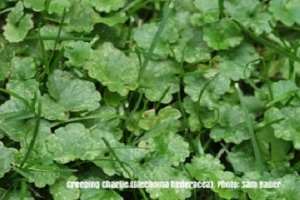
Self-heal
Self-heal (Prunella vulgaris) is a forb from the mint family, Lamiaceae, that receives its name from its history in folk medicine. A sub-species of this flower, Prunella vulgaris ssp. Lanceolata, is native to Minnesota, making self-heal a useful addition for landowners that want to attract native pollinators. This flower will grow in home lawns, especially moist areas that receive partial shade. The central stem of a self-heal flower is distinctive due to its spiked, hairy vegetation that stands upright. The striking flowers have a violet color and a whorled bloom, giving a tubular shape to the flower. The tubular shape of self-heal flowers make the nectaries difficult to reach for short-tongued bees. As a result, self-heal is most frequently visited by long tongued bees, like bumble bees and honey bees (tongue size is strongly correlated with body size). Self-heal is able to withstand regular mowing, blooming at heights as low as two inches.
Creeping thyme
Creeping thyme (Thymus serpyllum) is another flower from the mint family (Lamiaceae) that is most commonly found in sandy soil areas, but has the ability to establish in a variety of habitats. Creeping thyme grows by spreading lateral stems in the form of above ground stems (stolons) or below ground stems (rhizomes). Closely related to the culinary species of thyme, Thymus vulgaris, this species also retains a strong, herbal scent. The leaves of this plant grow low to the ground in opposite pairs, with flowers that will bloom at heights as low as one inch. The flowers are pink-purple in color, and form small, open blooms. The size of these blooms makes the rewards accessible to smaller bees, like mining bees, but may also be visited by honey bees. In addition to supporting bees, this plant also serves as important habitat for butterflies. Two species of butterflies, the small blue butterfly and the large blue butterfly, will lay eggs on the vegetation of creeping thyme. Their larvae will then feed on the leaves before maturing into adult butterflies. Creeping thyme is also useful as a border plant for gardens, as it acts as a natural deer deterrent.

Dandelion
Dandelion (Taraxacum officinale) is a common perennial lawn weed not only throughout the Unites states, where it is present in every state, but globally. Dandelion is native to Europe and Asia, but is now present on all continents except Antarctica. This herbaceous forb is able to establish in a wide variety of conditions and will bloom in full sun, part sun, or full shade. Dandelion is found frequently in disturbed soils, especially those that are high in potassium content. The leaves of dandelion vary in size based on the age of the plant, but are easily recognized by their unique, lobed shape. Dandelion has conspicuous yellow flower heads, containing many individual ray flowers. This species spreads easily once established in the soil due to dandelion’s prolific seed production and the ability of these seeds to be distributed widely by the wind. Dandelion does not require pollination and is able to reproduce via apomixes, a form of asexual reproduction in plants. Despite this, dandelion still produces nutritious pollen that is moderately high in crude protein content. Although it is often considered a nuisance in residential and recreational lawns, a wide range of insects use dandelion as a source of forage, including many types of bees. Honey bees, bumble bees, and a variety of solitary bee species will use this plant as a source of both nectar and pollen. Dandelion can survive and bloom despite mowing at low heights, making it an ideal candidate for a bee-friendly lawn.

Creeping Charlie
Creeping Charlie (Glechoma hederacea, aka ground ivy) is an aggressive lawn weed species that is found in every state in the United States, except for certain parts of the Southwest (NV, AZ, NM). This plant is considered an invasive species in some habitats, and tends to thrive in disturbed sites that are shady and poorly drained. Once established in a soil, creeping Charlie will spread quickly through aggressive stolons, forming mats that provide dense ground cover. The flowers of creeping Charlie are easily recognizable, with small, purple, tubular flowers arising from upright, square stems. Creeping Charlie has been the subject of heavy debate as to whether or not it should be used as a forage source for bees and other pollinators. While it has many desirable qualities, including ease of establishment and a low-growing nature, recent research suggests that creeping Charlie is not an ideal forage source due to its unique pattern of nectar production. Creeping Charlie exhibits wide ranges in both the quantity of nectar that it produces, and in the quality of the nectar (sugar concentration). While some flowers of creeping Charlie will produce great amounts of nectar high in sugar concentration, the average flower from this plant produces less than half the nectar quantity seen in comparable flowers like white clover. On average, nectar from creeping Charlie is higher in sugar concentration than that of white clover; however the range in sugar concentration is much more extreme. Because of this, creeping Charlie is considered an inconsistent source of nectar for visiting pollinators, and should be omitted for more reliable alternatives like dandelion and white clover.
Source: umn.edu